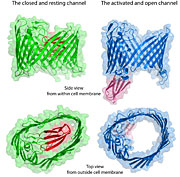- Number 339 |
- June 13, 2011
Bacterial protein secretes sticky appendages

The bacterial protein transport
channel in its resting closed
state (green)
and the activated
open state (blue).
[click here for larger image]
New atomic-level "snapshots" reveal how bacteria such as E. coli produce and secrete sticky appendages called pili, which help the microbes attach to and infect human bladder cells. These crystal structures — produced at the National Synchrotron Light Source (NSLS) at DOE’s Brookhaven Lab and the European Synchrotron Radiation Facility in Grenoble, France — unravel a complex choreography of protein-protein interactions that will aid in the design of new antibacterial drugs. Finding ways to interfere with pili formation could help thwart urinary tract infections, which affect millions of women around the world each year.
Two teams of scientists — one at Brookhaven and Stony Brook University, and another at Washington University School of Medicine and University College London — used a range of imaging techniques and computer modeling to produce the most complete picture yet of the pore-like transporter protein complex in the act of secreting sticky-ended pili. The research reveals two binding sites for pili subunits on this transporter protein, and details of how these sites work together to recruit, assemble, and transport pili components from the microbe cell's interior to its outer surface.
Blocking or removing either of these two binding sites may be a way to inhibit pilus formation — an idea already being explored in new drug-development investigations.
[Karen McNulty Walsh, 631.344.8350,
kmcnulty@bnl.gov]
